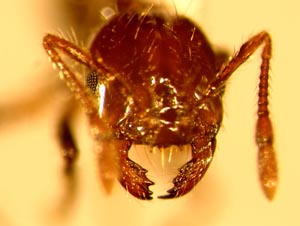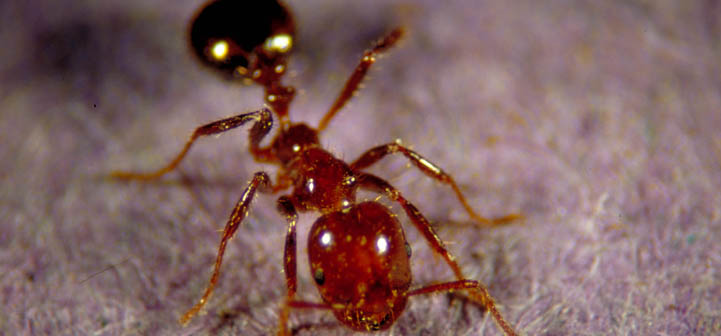FA Youth Home > Lessons: Fire Ant Physiques
Overview
How can you distinguish an ant from other insects? How can you tell one species of ant from another? Ants share important characteristics with all other insects.
Most insects have bodies that are divided into three parts and have three pairs of legs and a pair of antennae. When you’re trying to identify specific insects, it’s helpful to know and be able to name these body parts. The ant’s body has three parts to it — the head, thorax and abdomen. Like other insects, ants have an exoskeleton, an external covering that provides a protective casing around the body and a point of attachment for muscles, in contrast to the internal skeletons of humans and other vertebrates.
 |
 |
| Fire ant head. Photo by Matt Yoder. | Close-up of fire ant head showing four teeth on mandible. Photo courtesy, Texas Department of Agriculture |
Head
Unlike humans, whose brains are located in their heads, ants have little clumps of nerves in each region of their bodies that help control the activities in that area. Ants have poor eyesight and can detect only changes in light and darkness. Some ants are nearly blind. Rather than seeing, ants use their antennae to “smell” food, to sense their surroundings and to communicate with other ants. Ants have chewing mouthparts that they use to break food particles into sizes that are easily carried to the nest. However, they do not eat the solid part of foods; they only sip the liquids from the food particles.
Thorax
Most ants do not have wings. However, mature ant colonies produce winged males and females called “reproductives.” The reproductives fly from the nest to begin their own nests elsewhere. The wings (if present) and legs on ants (and all other insects) are attached to the thorax. The thorax is the center section of the ant’s body.
Abdomen
The third body section (at the rear) of an ant is called the abdomen and contains the digestive organs and the stinger (Note: not all species of ants have a stinger). The thorax and abdomen are connected by a waist-like extension of the abdomen called the petiole. Petioles can have one or two swellings, or nodes. Often you can count the nodes to help you determine the particular species of ant. For example, the fire ant has two nodes.
Coloration
Most ants cannot be identified by color alone, as many species of ants are similar in color. However, other characteristics can help you determine the specific identity of an ant. Some ants have hairy bodies; some have smooth bodies; and some have ridges, spines or dimples on their bodies.
- Vocabulary Words
Activities
Check out the following activities that will help you learn more about the parts of a fire ant.
- Fire ant Physiques: Build a Styrofoam Ant Model
- Fire Ant Physiques: What’s Buggin’ You?
- Fire Ant Physiques: Make An Ant
- Fire Ant Physiques: Rolling for Parts of an Ant
 |
 |
| Dorsal view of red imported fire ant taken with planar camera. Photo by Matt Yoder. |
Color profile view of Solenopsis invicta, the red imported fire ant. Sketch by Joe McGowan. |


